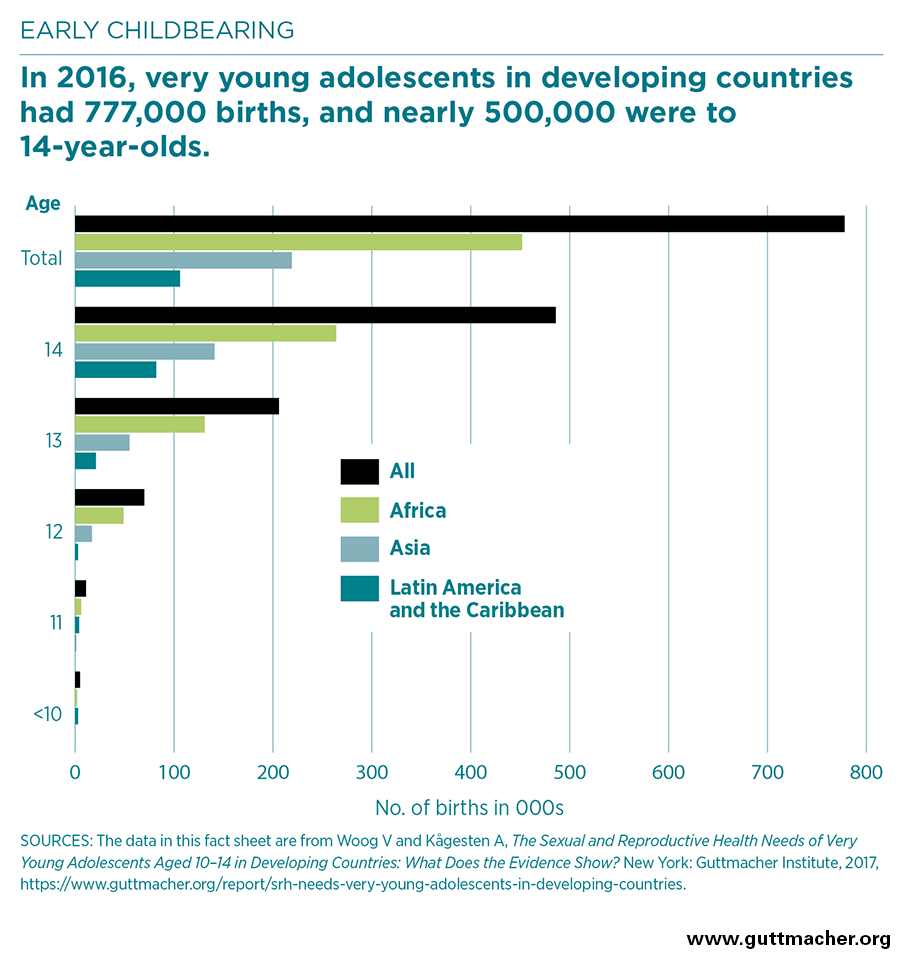- Very young adolescents, defined as those aged 10–14, represent 8% of the world’s population, and the size of this group is projected to grow.
- The vast majority of very young adolescents reside in developing countries. As of 2016, an estimated 545 million 10–14-year-olds live in developing regions: 346 million in Asia and Oceania, 143 million in Africa and 56 million in Latin America and the Caribbean.
- Early adolescence is a period of rapid physical, social, emotional and cognitive changes. As such, it is a critical time to lay the foundation for healthy and fulfilling sexual and reproductive lives.
Access to youth-friendly sexual and reproductive health (SRH) services
- While most very young adolescents report that they have never had sexual intercourse, some have begun to explore intimate relationships and to engage in noncoital sexual activities, such as kissing, hugging and fondling.
- According to a multicountry study of sexually active male and female students aged 13–15, condom use at last sex ranges from 26–81%; some studies indicate lower usage.
- Very young adolescent females in developing regions had an estimated 777,000 births in 2016; 58% of these births took place in Africa, 28% in Asia and 14% in Latin America and the Caribbean. Slightly more than one-third of births to mothers younger than 15 in developing countries were unplanned.
- Evidence shows that older adolescents in developing countries face numerous structural, cultural and legal barriers to obtaining SRH information and services, and it is safe to presume that barriers for very young adolescents are even greater.
- Common barriers experienced by adolescents include inability to afford services, negative attitudes among providers, breaches of confidentiality and privacy, lack of knowledge about services and where to find them, stigma and taboos around sexuality, and laws that prevent adolescents’ obtaining the information and services they need.
Comprehensive sexuality education
- As of 2016, in the majority of developing countries, more than 80% of very young adolescents are in school. Therefore, primary school is a valuable setting for the provision of comprehensive sexuality education (CSE) to very young adolescents.
- While many developing countries have national policies and curricula in place that support the teaching of CSE in primary schools, available data tell us little about the extent to which 10–14-year-olds are actually receiving CSE, or about the quality of such education.
- The available data on SRH awareness and knowledge—which mostly comes from studies in Sub-Saharan Africa—indicate that while very young adolescents have typically heard of HIV, in-depth knowledge of the topic is generally low, and awareness of how to prevent pregnancy is even lower.
Prevention of sexual violence and coercion, and child marriage
- For many very young adolescents—both females and males—first sexual intercourse happens as a result of coercion rather than choice, according to several multicountry studies conducted in Sub-Saharan Africa and the Caribbean.
- Between 3% and 23% of adolescent females aged 13–17 in developing countries report having experienced sexual violence in the past year; proportions range from 0% to 13% among adolescent males.
- Child marriage (marriage before the age of 18), occurs across many cultures and religions worldwide. While both boys and girls can be subject to child marriage, the practice affects girls disproportionally.
- Despite recent declines in child marriage in some regions, the United Nations Population Fund estimates that 50 million girls in developing countries could still be at risk of being married by age 15 within the current decade.
- The proportion of adolescent females married by age 15 in developing regions ranges from less than 1% to 24%, with great variation across and within regions. Child marriage is more prevalent among girls who reside in rural areas than among their counterparts in urban areas and among those from the poorest households, compared with those from wealthier households.
Recommendations
- Improve the evidence base on the SRH needs of very young adolescents in developing countries by filling critical research gaps. More data are needed that focus specifically on the 10–14 age-group; on young adolescent males’ experiences and needs; and on the most marginalized or vulnerable groups of very young adolescents, including refugees and other displaced people, LGBTQ adolescents, out-of-school adolescents, adolescents exposed to transactional sex, those living with HIV and those with disabilities.
- Ensure that very young adolescents have access to SRH services. Four key approaches have been identified in a review of interventions as successfully increasing the uptake of SRH services among adolescents: training providers to offer nonjudgmental and youth-friendly services, creating welcoming health facilities, informing adolescent girls and boys about services and encouraging them to use them, and establishing community members’ support for providing services to adolescents.
- Continue to prioritize evidence-based interventions to keep very young adolescents, and particularly girls (including those who are pregnant or are already mothers) in school.
- Implement national CSE policies and curricula. The years 10–14 provide an opportune window of time in which to provide CSE to help empower very young adolescents to make informed decisions about their own and their partners’ health once they initiate sexual relationships.
- Address the structural and social causes of gender-based violence and child marriage, such as discriminatory attitudes toward girls and women, including by scaling up programs that promote equitable gender norms.
Sources
The data in this fact sheet are from Woog V and Kågesten A, The Sexual and Reproductive Health Needs of Very Young Adolescents Aged 10–14 in Developing Countries: What Does the Evidence Show? New York: Guttmacher Institute, 2017, https://www.guttmacher.org/report/srh-needs-very-young-adolescents-in-d….
Acknowledgments
The report on which this fact sheet is based has been made possible by UK Aid from the UK Government and a grant from The Children’s Investment Fund Foundation. The views expressed are those of the authors and do not necessarily reflect the positions and policies of the UK Government or The Children’s Investment Fund Foundation.
